
Original Link: https://www.anandtech.com/show/2054
TripleHead2Go: The Latest External Multi-Display Upgrade from Matrox
by Josh Venning on July 31, 2006 12:05 AM EST- Posted in
- GPUs
Introduction
A while back we got a chance to look at a little box from Matrox called the DualHead2Go. This was basically a little black box which split a single video signal so that it could be output onto two separate displays. We found it to be an interesting piece of equipment that showed potential in certain areas like gaming and office situations, but was somewhat limited in its use. We would have liked to have seen a dual-link DVI version of the DualHead2Go, and while the wide resolutions were nice, the split down the middle from the sides of the two monitors pressed together made it all but useless for most types of gaming. This is assuming you couldn't afford the awesome yet outrageously expensive dual video projector setup of course.
Recently though, Matrox has released the aptly named TripleHead2Go, which not surprisingly does just what its name suggests: adds support for a third display. Now instead of only having two monitors side by side, three can be used with your system (using this box) to create a much wider display. Like the DualHead2Go, the TripleHead2Go is a stand-alone peripheral whose only purpose is running multiple displays with a laptop or desktop. Most newer graphics cards already had the capability of doing what the DualHead2Go could do, so that particular device was mostly just practical for notebooks or older desktop systems that only have a single analog video output. The TripleHead2Go with its three display capability might prove more desirable to the contemporary PC user.

Of course there are several applications for a device like this including gaming and the additional desktop space for use in office presentations or workstations. With the Parhelia, Matrox was first to bring triple-head support to PCs a few years back, but not until now have they provided an external triple-head device with the kind of 3D gaming capabilities of the TripleHead2Go. It looks as though with the TripleHead2Go, Matrox manages to offer the kind of multi-display gaming experience that the DualHead2Go just couldn't quite provide.
We'll take a look at the TripleHead2Go in the next section, and talk about the hardware and drivers and how they differ, if at all, from the DualHead2Go. As can be expected, the TripleHead2Go has a higher price tag than the DualHead2Go, and at about $270 right now, it's not very cheap, especially considering how much more the average user might have to pay for a decent triple-display gaming setup. For those users who can afford it, however, the extra-widescreen resolutions that become available are quite impressive to behold, as the images below suggest. (Images courtesy of Matrox.)
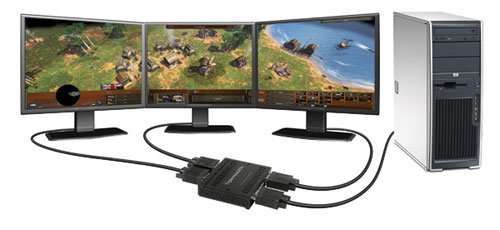 |
 |
 |
| Click to enlarge |
We'll talk more about gaming performance later, but for now, let's look at the Matrox TripleHead2Go.
The TripleHead2Go
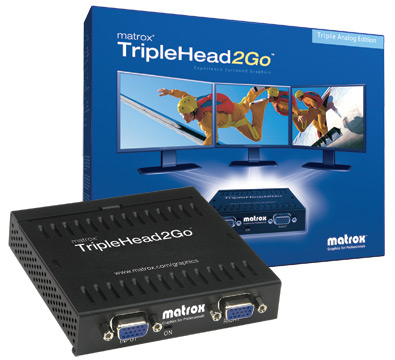
Like the DualHead2Go, the TripleHead2Go is simply a box with one VGA input, but instead of two VGA outputs there are three. The device basically digitizes the analog VGA signal from your laptop or computer, and splits (or clones) it twice to send it through three DACs for connection to the individual displays.

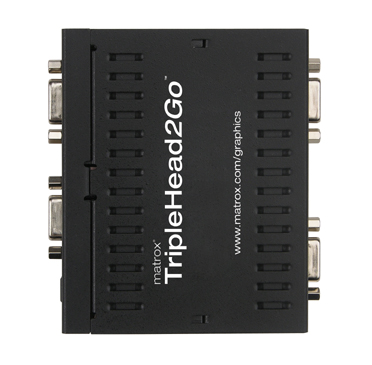
Everything about the TripleHead2Go is straightforward, and they didn't change things much in terms of looks and design from the DualHead2Go. The box is still small and compact, with four VGA connections instead of three, and the 5VDC power connection as well. The TripleHead2Go logo is on the top and there is also a power light indicator by the power connection to show that the device is on. The TripleHead2Go is very portable because of its size, which laptop users will appreciate, though transporting three displays around would be a different story.
When we open it up, the inside looks nearly the same as the DualHead2Go.

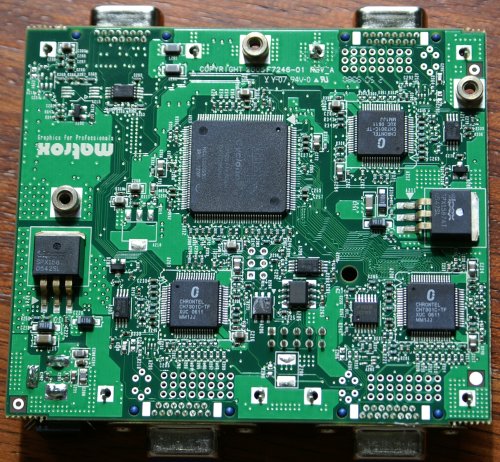
This time, it looks like Matrox is feeding the input straight into a Philips TDA8754HL video ADC rather than the Analog Devices part used in the DualHead2Go. This time around we see three CH7301C single-link transmitters for each of the displays we can connect to the TH2G. Again, there are two Cyclone EP1C chips used to drive the device. It is obvious that the TripleHead2Go is a next step revision of the DualHead2Go, and this time the ADC and FPGA on top of the board have heatsinks attached.
Installation and Configuration
The Matrox TripleHead2Go can still be classified as an "External Multi-Display Upgrade for Laptop and PC" (as the DualHead2Go was), but the tag line underneath the logo on its box refers to "Surround Graphics," something that a three monitor display hints at more than actually achieves.


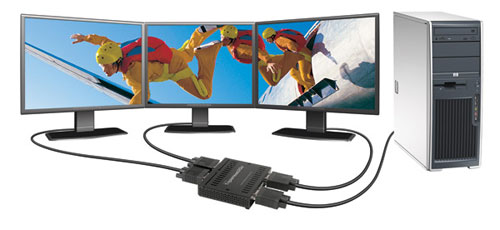
The TripleHead2Go can stretch an image across three displays, and also let you use your laptop screen as a fourth display. This provides even more flexibility for presentations or desktop applications for laptop users. The maximum resolution that can be achieved with the TripleHead2Go is 3840x1024, and it should be noted that as of right now, ATI GPUs don't support this resolution. Also, CrossFire does not support the TripleHead2Go, but NVIDIA SLI does, which is a definite drawback for ATI users. ATI has stated that this is a driver issue and not a hardware issue. They still haven't decided on whether or not to add support for the TH2G at this point. You can find a breakdown of the resolutions available on different equipment and other compatibility information about the TripleHead2Go here.
Something to note is that the TripleHead2Go offers a higher maximum resolution than the DualHead2Go, which makes sense given the extra display it supports. The TripleHead2Go can still be run as a dual head however, and if so will only support a resolution up to 2560x1024; which is also the max for the DualHead2Go.
This is the menu we see when we run the installation CD.
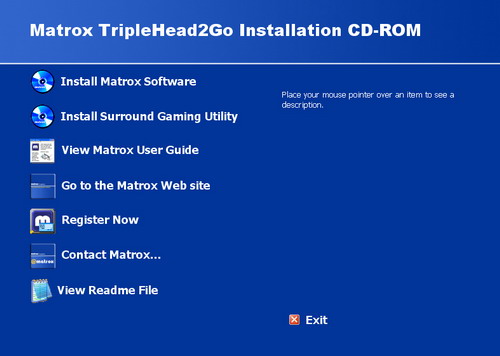
The Surround Gaming Utility is a handy program which will optimize any supported games installed on your system for widescreen surround resolutions. You can then choose to create a separate shortcut on your desktop which will run a specific game with the widescreen resolution of your choice.
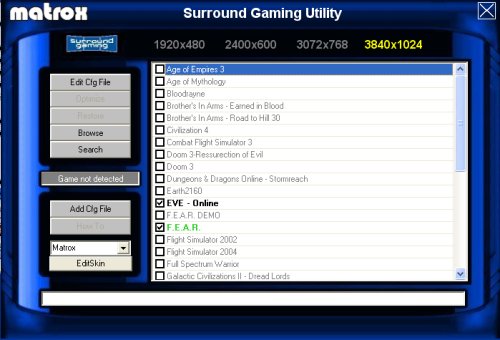
The driver interface for the TripleHead2Go is basically identical to the DualHead2Go's, and is just as easy to navigate.
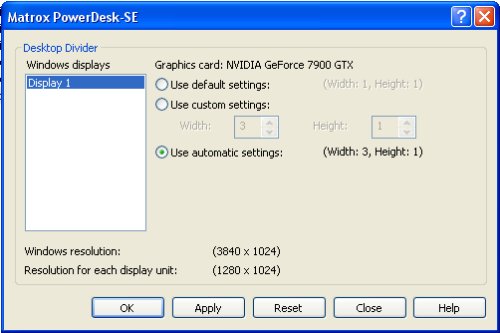
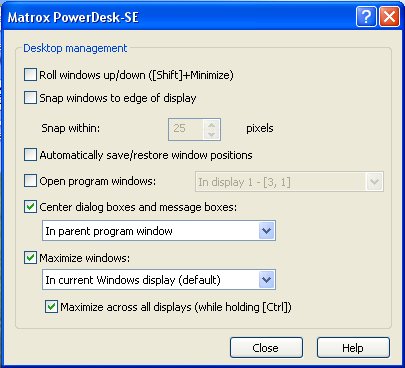
Once the device is hooked up and your system powered on, the drivers will automatically detect your setup and configure it for a widescreen display. You can also choose to duplicate displays instead of combining them for presentations and such.
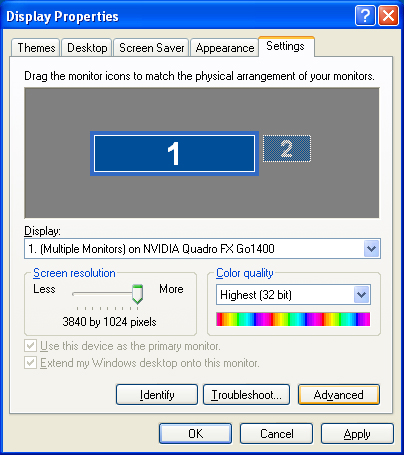
Performance
The fact that the TripleHead2Go allows for wider resolutions naturally results in higher performance demands on your graphics hardware. We wanted to get a basic idea of how well our system was able to run benchmarks in both Quake 4 and Half-Life 2: Episode One at the highest resolution possible (3840x1024). As we mentioned before, ATI hardware isn't able to achieve this resolution, so instead we tested one of the most powerful NVIDIA cards we had, the EVGA e-GeForce 7900 GTX (Factory overclocked to 690MHz/1.76GHz) with and without AA.
Here are the specifications of the system we used, along with the benchmark results for a couple games:
AMD FX-57
2GB DDR 400 RAM
NVIDIA GeForce 7900GTX
Seagate 7200.7 Harddrive
OCZ 700W PSU
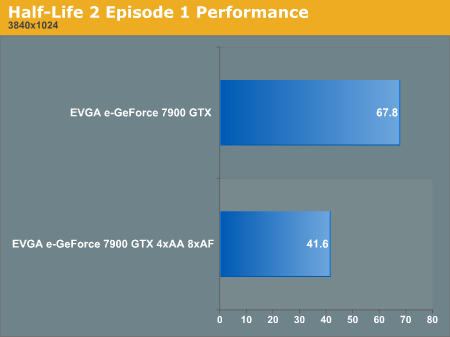
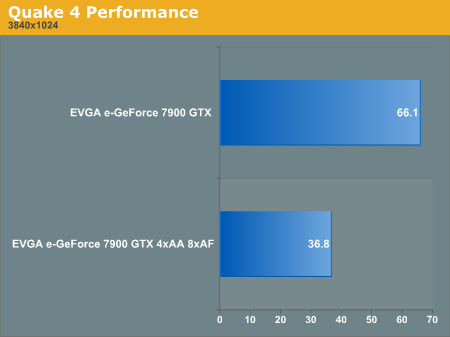
Considering the sheer power of the EVGA 7900 GTX, the results we see here are interesting. While this card runs these tests fairly easily, less powerful cards will definitely have their limits pushed with this resolution, especially with AA enabled. This means a graphics upgrade might be required, which in turns means higher cost for the potential buyer. As of right now, ATI users won't be able to run games at the highest resolution (3840x1024) due to an apparent driver issue, but hopefully this as well as the Crossfire issue will be fixed in the near future. Until then, it looks as though NVIDIA users will benefit most from the Matrox TripleHead2Go.
Power Consumption
Besides the raw GPU power required to run this device with games, we were also interested to find out what kind of power draw we could expect from something like the TripleHead2Go. We measured the overall wattage of the device at the wall from its external power connection, which looks very similar to a laptop power cord. Also, we took power readings while the system was idle at the highest resolution (with only windows running 3840x1024 across three monitors) and under load (running a game at the same resolution). Here are the results:
| Power Draw | |
| Idle | 4W |
| Load | 10W |
We can see that the TripleHead2Go draws very little power, which is a plus, and the fact that it has an external power connection means that you won't have to worry about any extra strain on your computer's power supply. That does mean you will need one more power socket near the computer when using the TH2G, but since a power strip will likely be needed to drive three displays plus the PC already that shouldn't be a problem.
Final Words
For any gamer, the thought of a box like the TripleHead2Go most likely brings first to mind what it would be like playing your favorite game with the additional screens on each side, and a widescreen resolution which stretches out into your peripheral vision. This type of display setup seems better suited for simulation games, particularly flight-sims, where the breaks between monitors would be less noticeable. However, the TripleHead2Go solves the DualHead2Go's problem of having a break in the middle of the screen due to the two displays being side by side, making wide-screen first person shooters more feasible.
The idea of being a sniper for instance in Battlefield 2, and having the wider field of view that a resolution like 3840x1024 provides would potentially give you an edge over those players that don't, being able to see enemies who might try to sneak up on you from the side. However, the breaks on each side can still be quite bothersome in fast paced first-person games where having a clear field of view is important. In games like Age of Empires 3, the extra view can potentially make a difference when managing units, allowing you to select and control very large numbers of units more easily than before. Simulation games like Microsoft Flight Simulator seem to be best suited for a three-monitor display, and with a powerful graphics card and/or SLI setup the view can be breathtaking.
These are just a few examples, and there are other types of games or 3D applications that can also benefit from the extra displays, but we still find the breaks between monitors too much of a distraction to make it worthwhile with most games. There is one slight problem, however: not all games are supported by Matrox's SGU application right now, and some games may never see support. For example, while we listed Battlefield 2 above, it is at present a hypothetical example, as it is not currently supported. You can try to force the proper resolution, but you will not get the correct field of view. There are at present 120 game titles officially supported, and presumably more will be added, but there are certainly going to be titles that never receive support. Anyone familiar with widescreen gaming will probably already recognize this fact, but proper TH2G resolution support in games is going to be even less common.
Of course, the TripleHead2Go isn't just for gaming. For those with laptops in office situations, the added desktop space is good for running multiple applications, or large media editing programs, and could theoretically boost productivity. However, how much your productivity will skyrocket over what you could normally accomplish on a single display is subjective, and this is where the price tag will determine for each individual if it's right for him or her. Being able to have the extra desktop space that the TripleHead2Go provides might be very practical, but any PC user can get extra desktop space by adding another GPU for less than the cost of a TripleHead2Go. This is why it seems that the TripleHead2Go is a fairly specialized piece of hardware that won't be practical for the average PC owner.
As with the DualHead2Go, the TripleHead2Go does exactly what it claims to do without any problems, and we were able to install and set up the drivers fairly easily. While the 3D gaming is much improved with the device, we would still prefer not to be limited to analog and have a dual-link DVI version of the TripleHead2Go. The fact that at the maximum resolution only a refresh rate of 60hz is supported is unfavorable to some, but is understandable given the limitations of this device.
As we mentioned in the introduction, the TripleHead2Go can be bought for about $270 at the time of this writing ($250 if you are a student). This is no small amount of money, considering this device requires a computer with a graphics card and three monitors to be of any use. On top of this, because the resolutions it can achieve are so large, a powerful graphics card for your system would be preferable. The cost of the device, graphics card, as well as the extra monitors would be pretty staggering, so those with extra monitors or a powerful graphics card would be much more likely to consider this than someone looking to make a triple-display system from scratch. Regardless of this, Matrox has provided the first realistic device to allow a triple-display setup, and is no doubt counting on the fact that there are those willing to get a setup like this by any means.
To sum up, the TripleHead2Go is a good quality, albeit expensive, device for setting up a triple display system without much trouble at all. While it's really the only way to get the type of "surround graphics" that it claims, we see this as more of a novelty item than a practical one for most users. The kinds of users who would really benefit the most from this are die-hard gamers (preferably simulation type games), and laptop owners who really want to impress people with their three screen presentations. Other users would be better off upgrading their monitor(s) to widescreen LCDs, or using a big-screen TV for a display, and those (desktop users) needing extra desktop space across multiple monitors can already get that sort of feature by purchasing a second graphics card with dual DVI connections. The TripleHead2Go's negative aspects like high performance requirements for gaming at high resolutions and compatibility issues (with ATI hardware) might ultimately be overshadowed by the positives, but the bottom line is the Matrox TripleHead2Go is a piece of hardware that, in spite of what it achieves, isn't worth the high price for most people.







